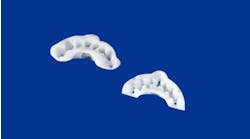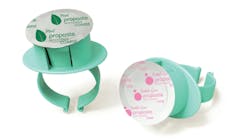The percentage of the population who are elderly is increasing. Are you prepared for the increase in oral disease among your senior patients?
by René Stephenson, RDH
A little more than a century ago, approximately three million Americans were age 65 and overm accounting for only 3 percent of the population. In 2000, those numbers increased to nearly 36 million — about 13 percent of the population — and is projected to reach nearly 20 percent by the year 2030.20 As the population of elderly increases, potential oral and systemic disease will also increase.
One reason oral disease will increase in the elderly population is the increased intake of medication. The Journal of the American Medical Association reported in a 2002 study that the average adult takes at least one medication a day and 25 percent take at least five a day, and those numbers are increasing for adults over 65.6 This decrease of saliva presents oral ramifications and can contribute to impending systemic problems such as xerostomia. Oral salivary glands are responsible for about three pints of saliva each day, and produce antibacterial substances that protect the oral cavity. Saliva is responsible for producing calcium and phosphorus, which the teeth absorb, and lubricants that prevent food from sticking to the teeth and gums, and keep food on the right track through the esophagus.12
Some medications affect the oral mucosa and alter plaque compositions, salivary flow, and pH levels. Some also alter taste and tissue pigmentation, as well as cause gingival enlargement. Some over-the-counter vitamins affect the oral cavity and alter the effectiveness of prescription medications.6
Xerostomia is associated with altered taste and plaque formation, and also increases the risk for candidacies, systemic diseases and root surface caries.6 For the purposes of this article, the focus will be on root surface decay, why the incidence is higher in the older population, and treatment for the disease. Medical and dental professionals no longer believe that age alone causes dry mouth, although as a patient becomes older the salivary glands tend to be less productive.12 In order to comprehend the oral implications of xerostomia, one must first be conscious of the many medications that are responsible for xerostomia. Approximately 400 medications can have xerostomia as a side effect.6 The related box lists the categories of drugs associated with xerostomia.
Clinicians should determine the reasons for decreased saliva, then make recommendations to help the patient produce more saliva and decrease those things associated with the saliva malfunction. The inside of the lower lip contains hundreds of tiny salivary glands that produce a pool of saliva in the floor of the mouth.12 If this area is lacking a saliva pool, the patient will have more plaque and sticky biofilm on the teeth.
Dental biofilm consists of some 500 bacterial species.7 Saliva helps by moving bacteria around and keeping it from adhering to the tooth structure. When the salivary clearance levels are low, there is a prolonged availability of sugar to the microorganisms of the dental plaque.3 As biofilm ages, it exhibits an increase of gram-positive bacteria, which increases the probability of decay.7
Many other issues must be addressed when considering the causes for xerostomia. Alcohol consumption and mouth rinses with high alcohol content can decrease saliva flow, as can tobacco use and some over-the-counter herbal products. It is estimated that 25 percent of the population uses herbal and dietary supplements on a regular basis.6 In an effort to make recommendations, the clinician should take a thorough health history and ask questions about the patient’s daily cleaning techniques, alcohol and tobacco consumption, nutritional status, and pH levels, which are all risk factors for increased decay.3
Improving Saliva Flow
Some basic procedures that will help decrease decay and improve saliva flow include eating fibrous foods, limiting alcohol content, chewing sugar-free gum, drinking tap water, using an anti-microbial mouth rinse, using over the counter moisteners, and maintaining proper oral health.12 Recommendations such as eating fibrous foods will not only help sweep bacteria and plaque off the teeth, but benefit a patient nutritionally.
The use of sugar-free gums helps stimulate the salivary glands to produce more saliva. Mechanical removal of plaque is very important in maintaining a more stable oral cavity and helps reduce the number of bacteria that adhere to the tooth structure. Tap water is an important element in controlling decay because many people consume great amounts of bottled water, which does not have fluoride and may be highly acidic. High levels of fluoride can also be very beneficial.12 Products that moisten the oral cavity can be extremely useful for patients with little or no saliva.
After the clinician has determined the possible cause for xerostomia, he or she should determine the patient’s propensity for increased decay. A clinician can determine if a patient is low risk, medium risk, or high risk through a simple risk assessment. Patients are low risk if they have not had a carious lesion in the last year, have regular dental visits, optimum fluoride use, sealed pit and fissures, good oral hygiene, adequately restored surfaces on minimal teeth, and are dentally aware.
Medium risk patients have fair oral hygiene, one carious lesion in the past year, root surface exposed teeth, irregular fluoride use, white spots and/or proximal surface radiolucencies, orthodontic appliances, and multiple restorations. A patient is considered high risk if he or she had more than two carious lesions in the last year, has low dental knowledge, frequent sugar intake, poor dexterity, unsealed deep pit and fissures, poor oral hygiene, irregular dental visits, radiation therapy, xerostomia, and uses chewing tobacco.4 As you can see, patients with xerostomia are high risks for carious lesions.
Another way to determine the prevalence for decay includes the use of a Saliva-Check kit by GC America. It includes a resting saliva flow test, a stimulated saliva flow test, and a buffering test. It includes everything necessary to determine the predisposition for increased decay due to decreased saliva flow and buffering ability. The resting saliva flow can be checked by examining the droplets that form at the orifice of the minor salivary glands. If it takes longer than 60 seconds for droplets to appear, the resting flow is below normal. The clinician can have the patient expectorate in a cup, measure the amount of saliva, and divide by 15. If the amount is 0.1 ml or less, it is an indication that the stimulation flow is low.
A simulated salivary test is also provided with the test kit. Patients are instructed to chew on paraffin wax for five minutes. While chewing on the wax, they spit into the cup provided. The level of saliva is measured for simulated flow. If the simulation flow measures below 3.5, the patient has a low saliva flow and increased propensity for decay. The final test is the buffering test. Using a pipette, the clinician removes one drop of saliva and places it on the test strip provided. After two minutes, the test strip should be compared to the strip indicator for saliva buffering ability. Red indicates poor buffering ability, blue indicates moderate ability, and green indicates the buffering levels are normal.21
When the clinician has determined the saliva flow, buffering ability, and propensity for carious lesions, he or she can then recommend treatments for decreasing the carious lesions. The first recommendation should include oral health and nutrition, followed by education about removing bacterial plaque, antimicrobial mouth rinses, high levels of fluoridation, xylitol gum, and the use of a calcium phosphate remineralizer.
Nutritional Considerations
Oral health and nutrition can have a significant effect on the systemic health of the older population. Chewing, swallowing and tasting all play an important role in nutritional status.19 Malnutrition also has an effect on the volume, physiochemical and antibacterial properties of a patient’s saliva. Poor oral health, including decay, can affect food choices, which in turn can affect the nutritional status of an individual. Clinicians should recommend meals rich in fibers, vitamins and minerals, as well as crunchy vegetables and breads. A diet that is high in sugar, carcinogenic foods, and fermentable carbohydrates will lower the pH balance in the mouth, adding to increased levels of decay.23
The clinician should explain proper oral hygiene instructions for plaque removal. Regular removal of bacterial biofilm from the oral cavity will help prevent the development of anaerobic-rich subgingival plaque and streptococcal bacterial, which are acid producers. Within the first three days, most of the bacteria in plaque consist of streptococcal and rod species, which increase the initiation of caries.15 These streptococcal bacteria produce acid as a byproduct of metabolism, which in turn metabolizes fermentable carbohydrates. The acids are responsible for dissolving the calcium phosphate minerals of the tooth enamel. When saliva buffering is not effective, there is an increase in carious lesions.10
Antimicrobial mouth rinses are widely used in an effort to reduce the bacterial loads in the oral cavity. Chlorhexidine gluconate (CHX) is regarded as a gold standard in short-term use for reducing the bacterial load. CHX is cationic and binds to bacteria, which are mostly anionic. This type of mouth rinse is considered a bactericidal agent that ruptures the cell walls and causes cell death. It is helpful when a patient has difficulty brushing and flossing, and reduces the levels of carcinogenic bacteria. Over-the-counter products, such as those with essential oils, reduce streptococcus mutans by 75 percent after 12 days when used twice a day for 30 seconds.
CHX and essential oils are also effective in anti-Candida properties.15 Studies have shown that daily use of CHX rinse for two weeks reduces the carcinogenic bacteria, and recolonization does not occur for three to six months.10
Fluoridation
A high level of fluoridation is another recommendation for those at risk for carious lesions. There are several types of professionally applied fluorides, including gels, foams, varnish, and fluoride toothpaste with 5000 ppm.2 Although fluoride varnish has not proven its effectiveness on root surface caries, there is clear evidence that it prevents decay. The American Dental Association endorses its use for caries reduction. Very few clinical studies show that foams and gels are effective in preventing caries.2 A 1982 study done by Petersson and Bratthall concluded that the use of fluoride contributed significantly to the decline in dental caries.22
Polyols is a sugar substitute that is a sugar alcohol. The most frequently used polyols include sorbitol, a hexatol derived from glucose and xylitol, which is a pentatol that widely occurs in nature. Because polyols metabolize slowly or not at all in dental plaque, products containing these substances do not promote caries. Chewing gums with polyols not only stimulate saliva flow, but neutralize the pH levels in the mouth.5 Studies show that chewing gums with xylitol have the ability to decrease streptococci mutans in the oral cavity. Xylitol also extends the mutans streptococci period after the cessation of rinsing with an antimicrobial mouth rinse like CHX.13
Using xylitol-sweetened gum in conjunction with diet modification, fluoride and antimicrobial mouth rinses appears to be helpful for those with a high level of caries.13 Sorbitol is a low carcinogenic sweetener rather than a non-carcinogenic one, and chewing two or more sticks of sorbitol gum a day increases both the acid production in plaque and the number of sorbitol-fermenting microorganisms. Sorbitol is the most common polyols in the United States, and is much less expensive than xylitol. Studies show that chewing sorbitol gum after a sucrose rinse reduces demineralization due to increased saliva flow.5
Due to a lack of saliva flow and plaque on the root surface, there is a decrease in the pH balance. The lack of buffering agents present in the oral cavity increases the propensity for demineralization. When saliva decreases in the mouth, there is also a decrease of calcium phosphate, which can drive minerals back into the tooth. Vegetables that are high in calcium phosphate can enter the partially demineralized crystal surfaces within the lesion and act as “nucleators” so that new surfaces can grow on the area.10 Foods that are high in calcium phosphate and proteins, such as cheese, help increase saliva flow and neutralize plaque acids. This process takes place when calcium ions and phosphate ions enter the tooth surface, which leads to new mineral formation.22 Investigators have concluded that the casein proteins in calcium phosphate products absorb into the enamel surface and provide resistance to acids and lead to enhanced remineralization.9
Due to the complex nature of root caries and predisposing factors associated with xerostomia, there are many things that should be taken into consideration. A thorough health history must be taken, along with a list of medications, oral health and nutritional health, assessment of decay perspicuity, buffering ability, and saliva flow.
After studying the complexity of xerostomia and associated tooth loss, I now realize that each patient is an individual, and no single treatment plan will fit the needs of everyone. Formulations must be made around each person’s needs and desires for a healthier mouth and better health. A combination of many different products can be individualized for each patient to ensure optimal treatment.
About the Author
Rene Stephenson, RDH, has been a clinical dental hygienist for 22 years. Rene has served as Texas Dental Hygienists’ Association vice-president and various council chairs. In 2006, she began a degree completion program at East Tennessee State University, where she will earn her bachelor’s in dental hygiene in May 2008. For information about courses she presents, visit www.TexasEducationalConcepts.com
References
1. Cohenm R, Kassab M, (2002). Treatment of gingival recession. Journal of the American Dental Association, 133, 1499-1506.
2. Affairs A D (2006). Professionally applied topical fluoride: Evidence-based clincial recommendations. The Journal of the American Dental Association, 137, 1151-1159.
3. Avlund K, Holm-Pedersen, Katz R P, et al. (2005). Dental caries, periodontal disease, and cardiac arrhythmias in community-dwelling older persons aged 80 and older: Is there a link? The American Geriatrics Society, 53 (3), 430-437.
4. Barber L, Wilkins E. (2002). Evidence-based prevention, management, and monitoring of dental caries. The Journal of Dental Hygiene, 76 (IV), 270-275.
5. Burt B. (2006). The use of sorbitol and xylitol sweetened chewing gum in caries control. The Journal of the American Dental Association, 137, 190-196.
6. Ciancio S. (2004). Medications’ impact on oral health. Journal of the American Dental Association, 135, 1440-1448.
7. Collins F. (2006, August). Biofilm formation, identification, and removal. Dental CE Digest, 1-8.
8. Danser M, Paraskevas S, Timmerman M, et al. (2004). Amine fluoride/stannous fluoride and incidence of root caries in periodontal maintenance patients. Journal of Clinical Periodontology, 31, 965-971.
9. DePaola D K (2002). Cheese consumptions and the development and progression of dental decay. Nutrition Reviews, 60 (4), 97-102.
10. Featherstone J. (2000). The science and practice of caries prevention. The Journal of the American Dental Association, 131, 887-899.
11. Gittins E, Sreenivasan P. (2004). Effects of low dose chlorhexidine mouthrinse on oral bacteria and salivary microflora including those producing hydrogen sulfide. Oral Microbiology and Immunology, 19, 309-313.
12. Harvard Health Department (2005, Feb.). Saliva shortage: Seven tips for a dry mouth. Harvard Health Letter, 4.
13. Hildebrandt G, Sparks B. (2000, July). Maintaining mutans streptococci suppression with xylitol chewing gum. The Journal of the American Dental Association, 909-916.
14. Hughes P. (2007). Aging, systemic disease and oral health: Implications for women worldwide. The Journal of Contemporary Dental Pratice, 8 (6), 1-13.
15. Kaplowitz G. (2006, Sept.). Essential elements of oral care. Academy of Dental Therapeutics and Stomotology, 1-6.
16. Lamster I. (2004). Oral health care services for the older adult: A looming crisis. American Journal of Public Health, 94 (5), 699-701.
17. Nield-Gehrig J. (2005). Dental plaque biofilm. Journal of Dental Hygiene, 14 (1), 13-17.
18. Overman P. (2000). Biofilm: A new view of plaque. The Journal of Contemporary Dental Practice, 1 (3), 1-7.
19. Sahyoun N. (2004). Tooth and mouth problems and nutrition among older people. Generations, 18-21.
20. Shay K. (2004). The evolving impact of aging America on dental practice. The Journal of Contemporary Dental Practice, 5 (4), 1-8.
21. Steinberg S. (2006). A paradigm shift for the diagnosis and treatment of dental caries. Retrieved Sept. 28, 2007, from GC America: http://www.gcamericq.com/ce/ceCourse.asp?courseID=5&defaultAssoc=5
22. Touger-Decker R., van Loveren C. (2003). Sugar and dental caries. American Journal of Clinical Nutrition, 73, 881s-892s.
23. Tougher-Decker R. (2005). Nutrition and oral health in older adults. Top Clinical Nutrition, 20 (3), 211-218.
Categories of Drugs Associated with Xerostomia6
Analgesics (central acting)
Angiotensin-converting enzyme inhibitors
Anorexiants
Antacids
Antiacne agents
Antiallegry agents
Anticholinergic/antispasmodic agents
Anticonvulsants
Bronchodilators
Calcium channel blockers
Decongestants
Diuretics
Muscle relaxants
Narcotic analgesics
Nonsteroidal anti-inflammatory drugs
Sedatives
Smoking-cessation agents
Antidepressants
Antidiarrheal agents
Antidysrhythmics
Antihistamines
Antihypertensive
Antinausea agents
Antiparkinsonism agents
Antipsychotics







